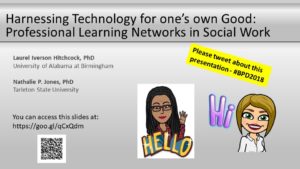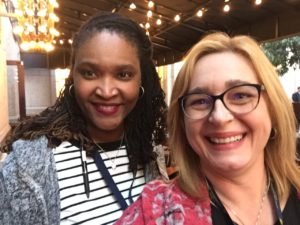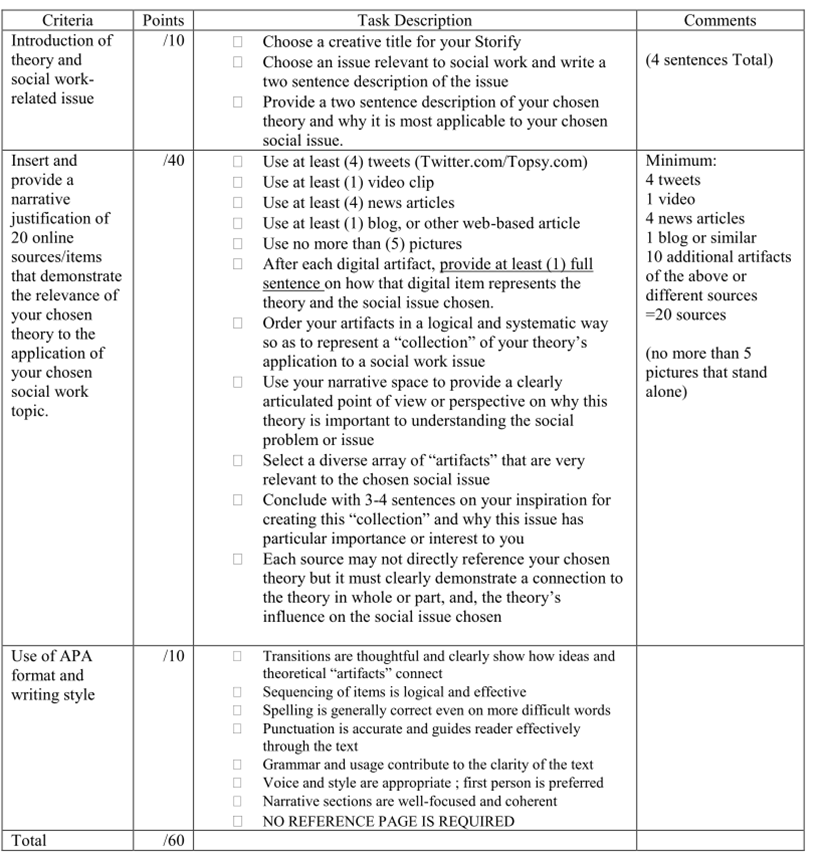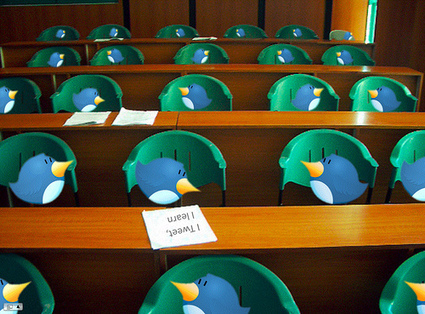#BPD2018 Harnessing Technology for one’s own Good: Professional Learning Networks in Social Work
 Today, Dr. Nathalie Jones and I will be presenting about Professional Learning Networks (PLNs) at the Association of Baccalaureate Social Work Program Directors in Atlanta, GA. This year’s theme is the Grand Challenges of Political Change, and we have been talking with our colleagues about how do we, as social workers, affect change in today’s political and social environments – change to improve the lives of vulnerable populations we serve; change to improve learning outcomes for our students; and change for ourselves as social work educators. Nathalie and I share a common desire to help other social work educators develop their own tool kits for teaching, scholarship, and service in their lives as academics, mentors, and partners with constituents and communities. One tool that we know works is having a Professional Learning Network, and we know this because it has worked for us – we met via Twitter using our PLNs. We have been working with our good colleagues – Drs. Melanie Sage and Nancy J. Smyth (both at the University at Buffalo) – to share what we know about PLNs to help raise awareness about this tool in social work education and practice.
Today, Dr. Nathalie Jones and I will be presenting about Professional Learning Networks (PLNs) at the Association of Baccalaureate Social Work Program Directors in Atlanta, GA. This year’s theme is the Grand Challenges of Political Change, and we have been talking with our colleagues about how do we, as social workers, affect change in today’s political and social environments – change to improve the lives of vulnerable populations we serve; change to improve learning outcomes for our students; and change for ourselves as social work educators. Nathalie and I share a common desire to help other social work educators develop their own tool kits for teaching, scholarship, and service in their lives as academics, mentors, and partners with constituents and communities. One tool that we know works is having a Professional Learning Network, and we know this because it has worked for us – we met via Twitter using our PLNs. We have been working with our good colleagues – Drs. Melanie Sage and Nancy J. Smyth (both at the University at Buffalo) – to share what we know about PLNs to help raise awareness about this tool in social work education and practice.
We hope you will join us at 1:45 PM in Georgia 2 in the Atlanta Sheraton. We will describe what what a PLN is and why to use one; demonstrate how to establish your own PLN and how to incorporate; and share how theory helps to inform the process of adopting technology tools for social work practice and education.
Here is a link to the slides from our workshop: https://goo.gl/qCxQdm.
You can also access a copy of the Professional Learning Network (PLN) Worksheet.
Using Storify in the Classroom: A Student’s Perspective from Natalie Savoy
Back in January, Dr. Jamie Mitchell from Wayne State University wrote about an assignment for her Human Behavior in the Social Environment Theory class that incorporated Storify, a social media platform that allows users to curate a digital narrative about any topic. The assignment required students to articulate how a theory of their choosing could be applied to a real-world, under-served population or problem of interest using Storify. As a follow-up to Dr. Mitchell’s post, I asked one her MSW students, Natalie Savoy, to share her thoughts on the assignment, what it was like to use social media in the classroom and how social media might be incorporated in her future role as a social worker. Here are Natalie’s responses to my questions:
What was your initial reaction to using social media for an assignment in your Human Behavior in the Social Environment Theory course?
Podcasting for Social Work Students, Part 2 – Why use podcasting in the classroom
 In my last post, I shared the basic mechanics of a podcasting assignment that has been a regular in my BSW marco-level practice course since 2011. While the post gives details about how such an assignment could be structured, it doesn’t really address why an educator would want to add a podcast assignment to their course? Changing assignments and adding technology to the classroom can be very challenging and sometimes involves a steep learning curve for the instructor and the students.
In my last post, I shared the basic mechanics of a podcasting assignment that has been a regular in my BSW marco-level practice course since 2011. While the post gives details about how such an assignment could be structured, it doesn’t really address why an educator would want to add a podcast assignment to their course? Changing assignments and adding technology to the classroom can be very challenging and sometimes involves a steep learning curve for the instructor and the students.
Using Storify to Explore Theory in the MSW Classroom by Dr. Jamie Mitchell
Dr. Jamie Mitchell is an Assistant Professor of Social Work at Wayne State University. In this blog post, Dr. Mitchell writes about how she incorporated Storify into a theory-based assignment for an MSW class last semester.
When I realized this past summer that a standardized core assignment in my regular Human Behavior in the Social Environment course had been changed in a way that limited the ability of students to explore a theory of their choosing during the semester, I began testing educational technology tools as a means of restoring that opportunity in a fresh way. I know from experience that some MSW students may view social and developmental theory as abstract and somewhat dated; and I work incredibly hard to highlight the relevance of having a strong theoretical foundation to praxis. It’s important to me that students connect with and write about at least one theory that engages them personally, leading me to develop this new assignment centered on Storify. Storify is a website that allows one to curate a digital narrative on any topic using an integrated social media search engine to locate sources such as tweets, blog posts, YouTube videos, and Google images. That “story” can then be published publicly and shared on other social media platforms.
My goal in developing this assignment was to give students an opportunity to articulate how a theory of their choosing could be applied to a real-world underserved population or problem of interest. Before the course began, I developed my own test Storify that could serve as an example to students and used it to develop a detailed rubric.
From the first day of class I introduced the new assignment and fielded questions from anxious students who were not comfortable with social media. To provide support for adopting Storify, I created a folder on my course website with existing tutorial videos and fact sheets on using Storify, and I developed my own resource for students on how to integrate a variety of content using bookmarklets to capture content around the web to import into Storify. I also worked through any glitches with students as they experimented with the platform and reserved a few minutes at the end of each class to demonstrate Storify functionality throughout the semester.
I was beyond impressed with how invested students were in creating high-quality digital narratives. The majority of students included more sources than were required, and went further in contextualizing how each source contributed to an understanding of the theory’s application to the issue or population than was required by the assignment rubric. Students also chose topics that were deeply personal to them and incredibly germane to the field of social work; covering topics such as human trafficking, school bullying, rape culture, racial profiling, immigrant experiences, inner city poverty, and LGBTQ empowerment. I used my own twitter account to share student projects, even tweeting prominent authors like Dr. Brené Brown when students utilized the Shame Resilience Theory she pioneered. I consider this initial foray into employing Storify as a course assignment to be a resounding success!
I would advise instructors who are interested in developing an assignment with Storify to familiarize themselves with the variety of existing resources such as free tutorial videos (Storify Guided Tour and Getting Started) and tip sheets, to experiment with the service themselves, and to explore the wealth of existing Storify stories for inspiration. Storify is free, intuitive, and user-friendly but it can be optimized by using additional strategies. For example, Google Chrome offers a bookmarklet or browser extension for Storify that allows users to bookmark content around the web and store it in a collection within Storify for later use. The website Topsy allows one to search for tweets by key words and hashtags as far back as two years, well beyond the six months that Twitter archives. Students may also find it useful to know that in addition to using the internal search engine within Storify, and using a bookmarklet to capture outside content, they can copy and paste the URL of any webpage into Storify to import content.
I’m excited about the possibilities for integrating Storify in other ways in my MSW classroom. This refreshing platform has proven to be a reliable and creative social media tool for encouraging students to research, contextualize, and curate content. Below are just a few examples of Storify submissions by my MSW students:
Feminist Theory, Slut Shaming, and Rape Culture by whitentonm
Racial Profiling: Do I Look Suspicious? by Tony Theel
Prison: The New Slavery by MStellini
Women in Sports: Woman first, athlete second by Natalie Savoy
Opening Our Eyes To The Truth About Older Adult Abuse by Melissa Stumpo
The Disney Princess Effect on Young Girls and Feminist Theory by sternb13
Walking the Tightrope of Motherhood by Ellen Coleman
**Note, Storify is a public domain and students are aware that all submissions are public until removed**
How to cite this post:
Mitchell, J. (2014, January 5). Using Storify to Explore Theory in the MSW Classroom by Dr. Jamie Mitchell [Blog Post]. Retrieved from https://laureliversonhitchcock.org/2014/01/05/using-storify-to-explore-theory-in-the-msw-classroom/.
Twitter: The Educational Commons By Justin Vest
Justin Vest graduated with his BSW from the University of Montevallo in December 2013 and begins the MSW program at the University of Alabama in January 2014. In this post, he discusses how his use of Twitter grew from a class assignment to a professional tool.
Twitter can be about celebrities and national or global trends, but I find its value in connecting users with educational content. I was first introduced to Twitter as an educational tool in Spring 2013 while taking Dr. Laurel Hitchcock’s class on social work with groups, communities, and organizations. The assignment encouraged students to engage with social media as a means of discovering information and connecting with other professionals. Over a relatively short period of time I have modified my own Twitter usage from that of fulfilling a course requirement to actively utilizing it as a tool for continuous learning. Above all else, I feel my role in the Twitter-sphere is that of student. I have a wide array of interests (mostly professional) that I keep up with via Twitter to the point that it is one of my primary sources for information regarding specific topics. To do this, I have created lists reflecting professional interests and categorized most of the people and organizations I follow into one of them. I am then able to filter out everything in my feed except tweets from pages within a specific list. Other Twitter users can also choose to follow these lists.
As a social networking site, Twitter can also be a valuable tool for networking with other professionals. While I don’t personally generate a lot of interactive content, I have found it to be very useful in connecting with other social workers who share my own interests in macro practice, particularly in areas of policy. Given the limited emphasis on macro practice within social work education, it is nice to be able to follow the work and thoughts of social workers employed in the macro arena. Several great resources that I’ve seen come from Rachel L. West including this one on how to search for macro job listings and this one on using social media to establish a career in macro social work. Others of note include:
- Melinda Lewis (@melindaklewis), author of Classroom to Capitol blog
- Congressional Social Work Caucus (@SocWorkCaucus)
- Congressional Research Institute for Social Work and Policy (@CRISPontheHill)
Perhaps the thing I find most fascinating about Twitter is its ability to give a voice to people who may not otherwise have the means to express their thoughts, feelings, and opinions. Twitter and other social media sites were credited, at least partially, with many of the successes of the Arab Spring. It was paramount to Occupy Wall Street organizers’ ability to call supporters to action at a moment’s notice and it provided a venue for many to express their frustration and educate others about issues of systemic racism in the U.S. after the verdict in the Trayvon Martin murder trial. Most of the pages I follow provide information that is not readily available via mainstream media sources and it is a great benefit to essentially use Twitter lists as a RSS feed pertaining to topics I want to learn more about.
One of my constant struggles with Twitter is determining what to share. The vast majority of my tweets contain links to outside sources, typically with the intent to inform others of something I believe is important or otherwise of note. Many things translate simply into an obvious category of professional interest like tweeting against cuts to the Supplemental Nutrition Assistance Program (SNAP) in order to prevent reduced access to food for low-income households. Other topics do not fall neatly into the purview of social work and may be more prone to divisiveness. My main concern with these topics (think partisan politics) is how it will appear to a potential employer, so I attempt to convey an educational message while not necessarily endorsing the content. I do also plan to get in the routine of blogging about policy issues from a social work perspective over the winter break as means of both exploring in greater depth some political ideas as well as highlighting my professional values and skills to potential employers.
How to cite this post:
Vest, Justin. (2013, December 9). Twitter: The Educational Commons By Justin Vest [Blog Post]. Retrieved from https://laureliversonhitchcock.org/2013/12/09/twitter-the-educational-commons/.







